TDCJ Inmate Search
The TDCJ Inmate Search is online tool provided by the Texas Department of Criminal Justice (TDCJ), the state agency responsible for the incarceration and rehabilitation of convicted offenders in Texas.
The TDCJ Inmate Search system has been developed to provide a clear overview of an inmate’s current status, location, and key details related to their incarceration. It was establishment of the first Texas State Penitentiary in Huntsville on October 1, 1849.
The TDCJ, as the state agency responsible for offender incarceration and rehabilitation, manages over 100 correctional facilities and an inmate population of around 137,106 as of Fiscal current year.
Texas Inmate search online service is for public convenience and safety. Unauthorized use is forbidden and subject to prosecution. While data is believed accurate, the State of Texas, TDCJ, its Board, and employees make no warranties on accuracy, timeliness, or completeness. The website updates on working days only, with information at least 24 hours old. Inmate relatives should call the unit before pickup.
For general questions please direct your inquiries via email to: classify@tdcj.texas.gov. For Additional information Click here: TDCJ Classification.
If you have issue describe the issue in an email to: webadmin@tdcj.texas.gov. Your problem will be addressed as quickly as possible.
Table of Contents
What is TDCJ Inmate Search
Texas Department of Criminal Justice (TDCJ) Inmate Search is a web resource from the Texas Department of Criminal Justice, the formal group in charge of Texas’s correctional system.
This tool lets people tap into a vast collection of public inmate records. These records span all correctional units and facilities in Texas, housing individuals from state jails to state prisons.
The system lets people look up inmates using offender names, TDCJ numbers, and SID numbers. It opens up inmate records, ensuring transparency and keeping users updated about current or past incarceration statuses.
The platform is specifically built to improve the public availability of inmate records. It’s also a tool for legal professionals, assisting in research, offender tracking, and keeping current with an inmate’s status. The system is accessible online. Anyone with internet access can pull up inmate details, as long as it’s public information.
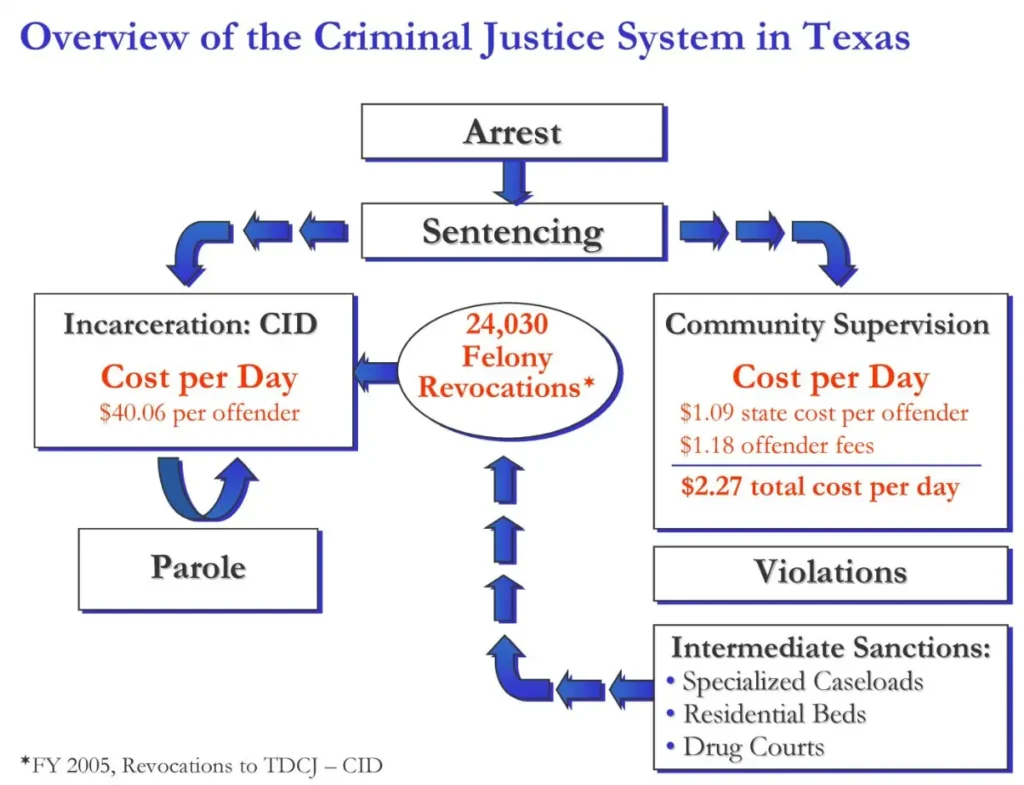
Types of Inmate Search TDCJ
The Inmate Search TDCJ portal serves as a critical public resource, offering specific categories of information about individuals under the Texas Department of Criminal Justice’s custody.
While it doesn’t provide every detail of an inmate’s life or complete court records, it focuses on key data points essential for understanding their current incarceration status.
When you successfully locate an individual through the TDCJ Inmate Search offender, the system will display the following essential information:
How to Access TDCJ Inmate Search offender
Accessing TDCJ offender search is straightforward. Here’s a step-by-step guide to using the platform:
Looking for information on an incarcerated individual in Texas? The TDCJ inmate list is your primary online tool. Follow these simple steps for a quick and accurate search.
The TDCJ Inmate list platform is mobile-friendly, making it accessible from smartphones and tablets. However, users with visual impairments may need additional screen reader tools, as the site doesn’t currently meet full WCAG accessibility standards
Step 1: Access Official TDCJ Inmate List website
- Navigate directly to the official Texas Department of Criminal Justice Inmate Search website.
- Upon arrival, you’ll likely encounter a disclaimer or terms of use. Read this carefully to understand the data’s scope and limitations.
- Agree to the terms (if prompted) to proceed to the search interface.
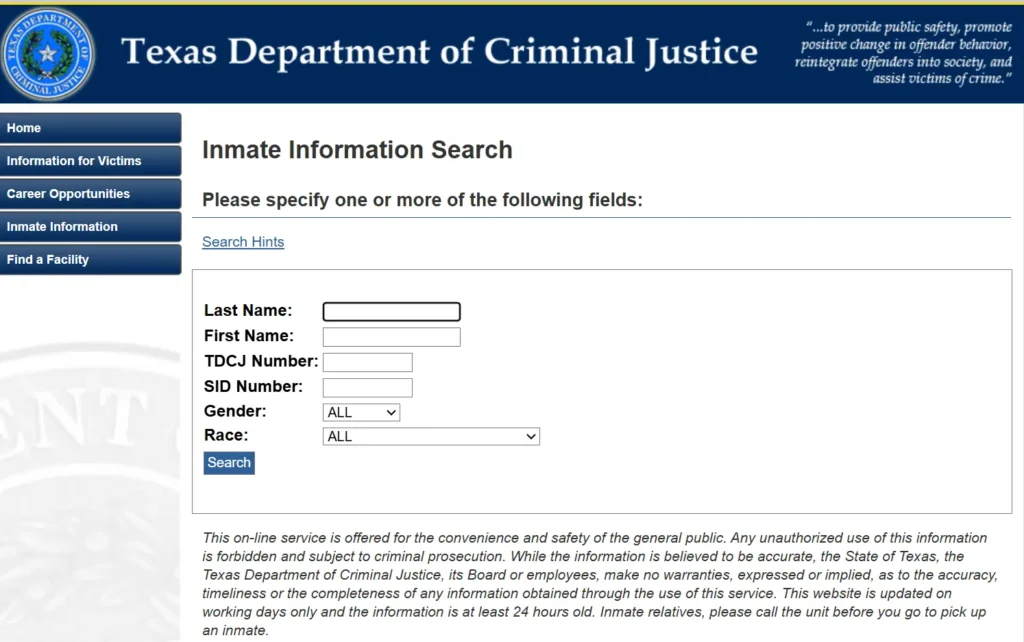
Step 2: Enter Your TDCJ Inmate roster Information
The main search page provides fields for different search methods. Choose the most accurate information you have:
- Search by Name:
- Enter the inmate’s Last Name (required).
- Enter at least the First Initial of their First Name.
- Example: Smith, J
- Search by TDCJ Number:
- Input the unique seven-digit TDCJ number. This is often the most direct method.
- Search by SID Number:
- Enter the inmate’s State Identification (SID) number.
Step 3: Use Filters to Refine Your Results
If your initial search (especially by name) yields many results, use these filters to narrow them down:
- Gender: Select “Male” or “Female.”
- Race: Choose from options like “White,” “Black,” “Hispanic,” etc.
These filters are crucial for quickly pinpointing the specific inmate you’re looking for.
Step 4: Execute Your Search & Review Matches
- Click the “Search” or “Submit” button.
- The system will display a list of inmates matching your criteria.
- To view detailed information about a specific inmate, click on their name or the designated link in the search results.
Step 5: Understand Texas Inmate Search Details
Once you access an individual inmate’s record, you’ll find comprehensive information, typically including:
- Inmate Summary: A brief overview, including their general status.
- Inmate Status: Current custody status (e.g., in custody, released, transferred) and current housing unit/facility.
- Offenses & Release: Specific crimes of conviction and any projected release or parole dates.
- Identification: The unique TDCJ Number and SID Number.
- Basic Demographics: Gender and Race.
- Admission Dates: The date the individual was admitted into TDCJ custody.
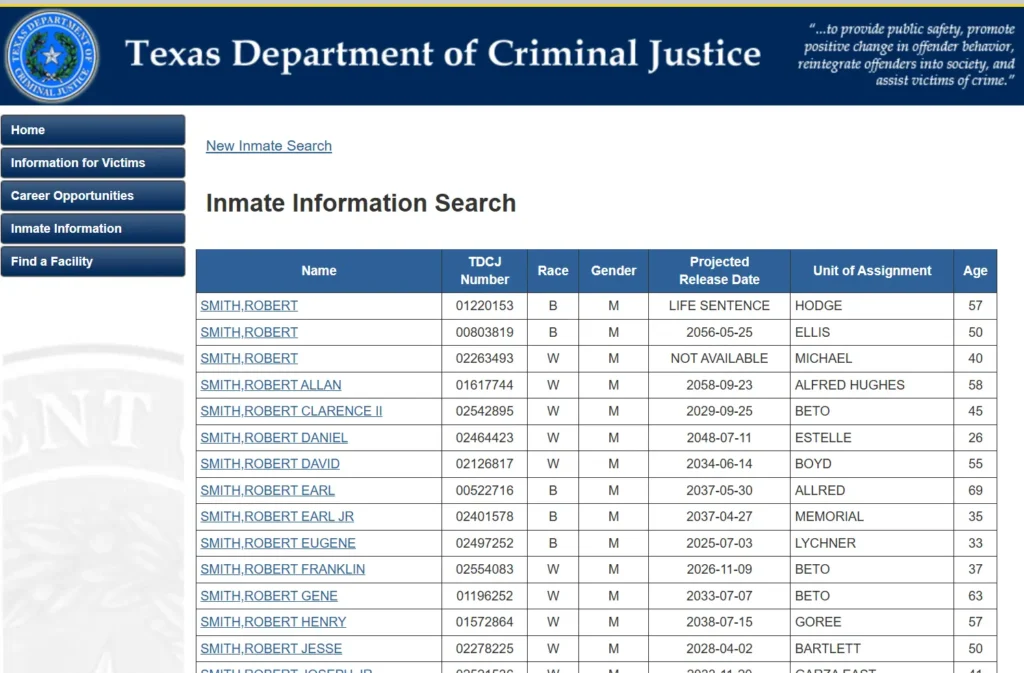
TDCJ inmate lookup Details
Here is sample data which will you get after searching it.
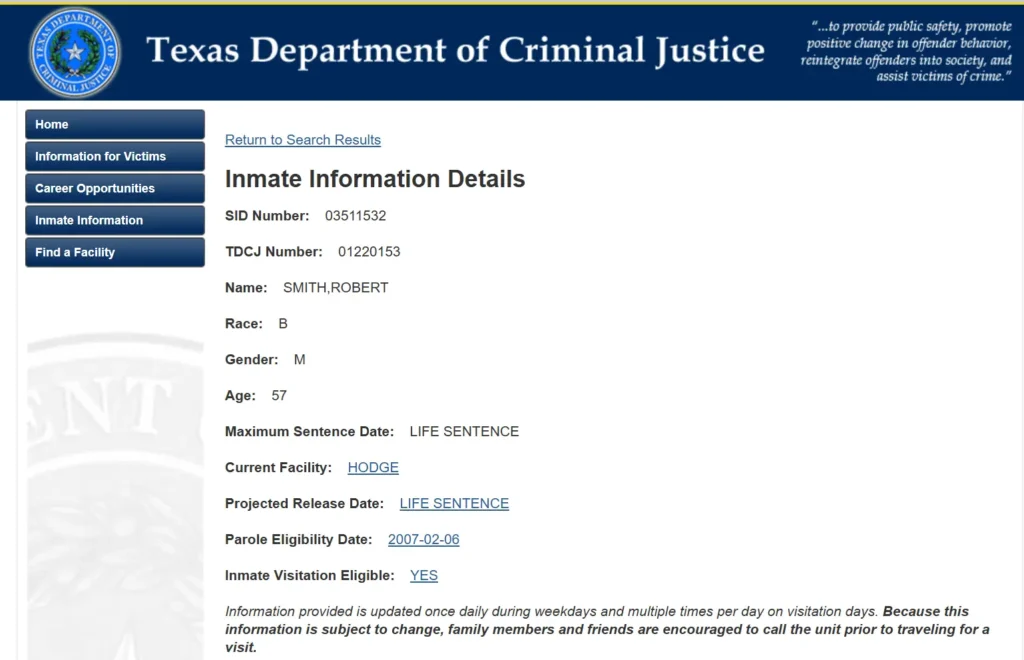
SID Number: 03794525
TDCJ Number: 01191672
Name: PERRY,GREGORY RAY
Race: B
Gender: M
Age: 60
Maximum Sentence Date: 2044-08-30
Current Facility: BETO
Projected Release Date: 2044-08-30
Parole Eligibility Date: 2022-03-01
Inmate Visitation Eligible: YES
Information provided is updated once daily during weekdays and multiple times per day on tdcj visitation portal days. Because this information is subject to change, family members and friends are encouraged to call the unit prior to traveling for a visit.
SPECIAL INFORMATION FOR SCHEDULED RELEASE:
Scheduled Release Date:
2025-07-14
Scheduled Release Type:
Parole
Scheduled Release Location:
HUTCHINS
Offense History:
| Offense Date | Offense | Sentence Date | County | Case No. | Sentence (YY-MM-DD) |
|---|---|---|---|---|---|
| 1990-03-19 | THEFT PROP 750-20,000 | 1994-04-15 | DALLAS | F-9031191-WS | 4-00-00 |
| 1989-11-24 | BURG OF BUILDING | 1994-04-15 | DALLAS | F-8973250-PSJS | 4-00-00 |
| 1998-01-17 | UUMV | 1998-03-24 | DALLAS | F-9843734-PJ | 1-02-25 |
| 1999-08-30 | AGG ROBBERY OF AN ELDERLY PERSON | 2002-03-21 | DALLAS | F-9937205-VM | 45-00-00 |
Note: The TDCJ system generally focuses on current inmates. Information about released or deceased inmates may be limited or unavailable online.
Who Benefits from TDCJ offender Search Tool
The TDCJ Inmate roster is a multifaceted tool that serves various crucial stakeholders within and beyond the criminal justice system:
What TDCJ Inmate records I can find on it
The Texas Department of Criminal Justice (TDCJ) operates primarily as the state’s correctional agency, managing prisons and incarcerated individuals. As such, the “TDCJ ecomm it does not directly provide detailed court records in the way a county District Clerk’s or County Clerk’s portal would.
Instead, the TDCJ portal focuses on information related to individuals within the correctional system that stems from court actions.
Here’s a breakdown of the “court details” you can typically find on the TDCJ portal:
- Access to Courts: Information regarding inmates’ constitutional right to access courts, including details about law libraries within units and attorney visitations. This section discusses the mechanisms for inmates to interact with the judicial system.
- Victim Services: This section may reference court events or outcomes related to victim notification (e.g., parole hearings that are decided by the Texas Board of Pardons and Paroles, which is related to but distinct from the courts). The Texas Attorney General’s office and Texas VINE (Victim Information and Notification Everyday) are the primary sources for court event notifications.
What you will NOT find on the TDCJ portal
find an inmate in TDCJ , you need to use:
In essence, the TDCJ portal provides a window into an outcome of the court process (incarceration) and related administrative details, rather than providing access to the court’s original records themselves.
How the Parole Status TDCJ Check
The Parole status tdcj process is a critical phase in an inmate’s journey through the Texas correctional system, offering a pathway to supervised release before the completion of their full sentence. The Texas Department of Criminal Justice (TDCJ) records are intricately tied to this process, forming the foundation upon which the Texas Board of Pardons and Paroles (BPP) makes its release decisions.
Here’s how the tdcj inmate search parole status process ties into TDCJ records:
Parole Eligibility Date Calculation
- TDCJ’s Role: Immediately upon an offender’s admission, the TDCJ’s Classification and Records Office calculates an initial Projected Release Date (Estimated) and a Parole Eligibility Date. This information, derived from the court’s judgment and statutory guidelines based on the offense type and sentence length, becomes a core part of the inmate’s TDCJ record.
- Factors: These dates consider factors like actual calendar time served, good conduct time (time earned for good behavior and program participation), and any statutory requirements for specific offenses (e.g., “3g offenses” often require a higher percentage of the sentence to be served without good time).
- Visibility in TDCJ Inmate roster: The “Projected Release Date (Estimated)” is directly visible in the public Texas department of criminal justice tdcj, giving families and legal representatives an initial benchmark for when parole consideration might begin.
Inmate’s Institutional Record:
- Behavior and Programs: The TDCJ meticulously maintains records of an inmate’s behavior, disciplinary actions, participation in rehabilitation programs (such as educational courses, vocational training, and substance abuse treatment), and work assignments.
- IPO Summary: When an inmate approaches their parole eligibility date, an Institutional Parole Officer (IPO) from the Texas Board of Pardons and Paroles interviews the offender and compiles a comprehensive case summary. This summary heavily relies on the inmate’s TDCJ institutional record, detailing their conduct, program completion, and any disciplinary history. This detailed internal record is crucial for the BPP’s assessment.
- Influence on Decision: A positive institutional record (good behavior, active program participation) significantly influences the BPP’s decision, signaling an inmate’s readiness for reintegration. Conversely, a poor disciplinary record can negatively impact parole prospects.
TDCJ Custody Status and Location:
- Inmate Search Utility: The TDCJ Inmate Search consistently provides the inmate’s Current Housing Location/Unit and Custody Status. This information is vital for the BPP during the review process, as it confirms where the inmate is currently held for potential interviews or transfer following a parole grant.
- Release Process: If parole is granted, the TDCJ’s Classification and Records department coordinates the release, ensuring all necessary administrative steps are completed before the offender transitions to the supervision of the TDCJ Parole Division.
Parole Conditions and Supervision:
- BPP’s Role: While the BPP makes the decision to grant parole and sets the specific conditions, the TDCJ Parole Division (a distinct division within TDCJ) is responsible for the actual supervision of parolees in the community.
- Ongoing Records: The parole division maintains ongoing records of the parolee’s adherence to conditions, regular meetings with their parole officer, employment status, and any new legal issues. Violations recorded by the Parole Division can lead back to the BPP for review and potential parole revocation, resulting in re-incarceration back into TDCJ custody.
NOTE: Compared to states like Florida or California, Texas’s TDCJ Inmate is one of the more detailed portals, offering projected release dates and parole eligibility, which aren’t always available elsewhere.
TDCJ Search for Legal Professionals
People in law, like attorneys, assistant lawyers, and law researchers, use TDCJ Search a lot. It makes getting details about inmates simple, so they can follow individuals, study past incarceration details, and keep up-to-date with what’s happening in current inmate statuses.
Legal professionals use TDCJ Inmate Search in the following ways:
TDCJ Inmate Search by name
Legal professionals use the platform to gather information on inmates that are relevant to their work, including incarceration histories, offenses of conviction, and release information.
Limitations of Texas Inmate Records
While TDCJ Inmate Search offers valuable information, it’s essential to be aware of its limitations. Only some inmate records are available; some may need to be completed or updated.
Clarifications for Texas Inmate Search Users
Here is clarification of the consusing points about Inmate Searches about users.
TDCJ vs. Other Custodies:
- The Texas jail inmate search only shows people in Texas state prisons and state jails (TDCJ custody).
- Not included: Individuals in county jails (awaiting trial or serving short sentences) or federal prisons.
- Where to search elsewhere:
County Jails: Check the specific County Sheriff’s Office website for that county.
Federal Prisons: Use the Federal Bureau of Prisons (BOP) Inmate Locator online.
Victim Support: Use VINE!
- While the TDCJ search gives info, VINE (Victim Information and Notification Everyday) is a better tool for victims.
- What VINE does: It’s a free, automatic notification system that alerts registered victims about changes in an offender’s custody status (like release, transfer, or escape) and court event changes.
- Why it’s important: VINE provides proactive, automated updates, offering crucial safety and awareness for victims.
The Cost of Incarceration:
- Running Texas’s large prison system is very expensive.
- Cost: On average, housing one inmate in a Texas state prison costs approximately $77.49 per day, which amounts to around $28,284 per year. This highlights the significant financial commitment behind the state’s correctional operations.
Texas Court Structure
Court Contact Information To address inquiries or schedule appointments, contact Texas’s courts using the information below (examples provided; specific county/city details vary):
Supreme Court of Texas: Phone: (512) 463-1312 Address: 201 W. 14th Street, Room 104, Austin, Texas 78701
Court of Criminal Appeals of Texas: Phone: (512) 463-1551 Address: 201 W. 14th Street, Room 106, Austin, Texas 78701
Fourth Court of Appeals (San Antonio example): Phone: (210) 335-2635 Address: 300 Dolorosa, Suite 3200, San Antonio, Texas 78205-3037
District Court (Bexar County example – Civil District Courts Admin): Phone: (210) 335-2300 Address: 100 Dolorosa, San Antonio, TX 78205 (main courthouse for many district courts)
County Court at Law (Tarrant County example – County Court at Law No. 1): Phone: (817) 884-1457 Address: 100 North Calhoun Street, Fort Worth, TX 76196 (main civil courts building)
Justice Court (Dallas County example – JP 1-1): Phone: (972) 228-0280 Address: 8301 S. Polk Street Suite 2100, Dallas, TX 75232
Municipal Court (Dallas example): Phone: (214) 670-0109 Address: 2014 Main St., Dallas, TX 75201
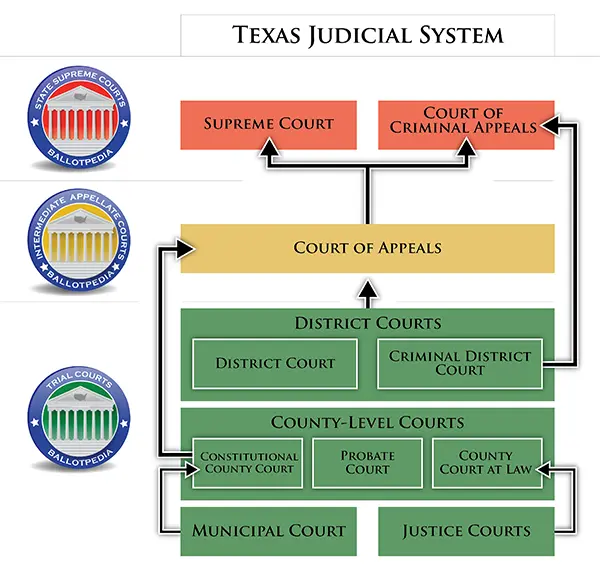
TDCJ Hours
It’s important to clarify that “TDCJ court hours” generally refers to the operating hours of courts that handle cases involving TDCJ inmates (e.g., District Courts, Appellate Courts) or the hours for attorney visits to TDCJ facilities, rather than the TDCJ itself having “court hours.” The TDCJ is a correctional agency, not a court.
Here’s a table outlining the most common operating hours for Texas courts and attorney-related access within TDCJ facilities:
| Entity/Type of Hour | Days of Operation | Most Common Hours (CST) | Notes |
|---|---|---|---|
| Texas State Courts | |||
| Supreme Court of Texas | Monday – Friday | 8:00 AM – 5:00 PM | The highest civil court in Texas. |
| Court of Criminal Appeals | Monday – Friday | 8:00 AM – 5:00 PM | The highest criminal court in Texas. |
| Courts of Appeals (14) | Monday – Friday | 8:00 AM – 5:00 PM | Hours can vary slightly by specific court location. |
| District Courts | Monday – Friday | 8:00 AM – 5:00 PM | Highly variable by county. While 8 AM – 5 PM is common for clerk’s offices, actual court proceedings and dockets have specific times set by individual judges. It’s crucial to check the specific county’s District Clerk or court website. |
| County Courts (incl. C.C.L.) | Monday – Friday | 8:00 AM – 5:00 PM | Highly variable by county. Similar to District Courts, clerk’s office hours are generally consistent, but court schedules vary. Always confirm with the specific County Clerk or court. |
| Justice Courts | Monday – Friday | 8:00 AM – 5:00 PM | Highly variable by precinct and county. Some may have shorter hours or specific days for certain types of hearings. |
| Municipal Courts | Monday – Friday | Varies widely | Highly variable by city. Many larger city municipal courts have extended hours or specific times for certain services (e.g., walk-in dockets). Some may close earlier on Fridays. Always check the specific city’s municipal court website. For example, some Austin Municipal Court locations have hours until 6 PM or 8 PM on certain days. |
| TDCJ Facility Access | |||
| Attorney Visits | Monday – Friday | 8:00 AM – 5:00 PM | Attorneys generally have access to visit inmates during regular business hours. Some facilities might have specific blocks when attorney visits are unavailable due to operational requirements (e.g., meal times, counts). It’s always best for attorneys to confirm with the specific unit beforehand. Attorneys may have more flexible access than general visitors. |
| Inmate Court Appearances | Weekdays | Varies by court/unit | Inmates attend court appearances (e.g., arraignments, hearings) as scheduled by the respective court. These are not “TDCJ hours” but rather court dockets that TDCJ facilitates transport to or participates in via video conference. |
Rehabilitation and Reentry Programs
The Texas Department of Criminal Justice (TDCJ) Texas penitentiary inmate search isn’t just about keeping people in prison; a big part of its job is to help offenders change and successfully re-enter society. This focus on “rehabilitation” is key to making communities safer by reducing the number of people who return to crime.
What Programs Does Inmate search Texas Offer?
TDCJ provides various programs aimed at preparing inmates for life after prison. These include:
Why TDCJ Inmate status Programs Matter
These efforts are vital because they directly link to recidivism, which is the rate at which former inmates commit new crimes and return to prison.
Limitations of Tdcj federal inmate search
While the TDCJ Inmate Search is an invaluable public resource, it’s crucial for users to understand its inherent considerations and limitations to ensure responsible and accurate use of the information.
Data Accuracy and Timeliness:
It’s important to approach the information obtained from the Inmate Search TDCJ with an understanding of its dynamic nature.
While diligent efforts are made to ensure the accuracy of the data presented, the Texas Department of Criminal Justice (TDCJ), its Board, and its employees do not offer any warranties, whether expressed or implied, regarding the accuracy, timeliness, or completeness of any information obtained through this service.
The correctional system is constantly in flux, with inmate movements, status changes, and administrative updates occurring regularly. Furthermore, this website is updated solely on working days only, and all information presented is at least 24 hours old.
This means that for critical, real-time needs, such as an inmate’s immediate release or transfer, the online portal may not reflect the most current status.
Legal Disclaimer & Restrictions:
The TDCJ Inmate Search is provided for the convenience and safety of the general public, serving legitimate purposes. However, it comes with a strict legal caveat: “Any unauthorized use of this information is strictly forbidden and may lead to criminal prosecution.”
This emphasizes that the data should not be used for illegal activities, harassment, or any purpose that violates privacy laws or poses a threat to public safety. Users are expected to respect these legal boundaries.
Verification of Information:
Given the aforementioned limitations regarding accuracy and timeliness, it is always strongly recommended to cross-reference critical details obtained from the TDCJ Inmates Search with official sources.
For example, if you are a relative planning to pick up an inmate upon release, it is explicitly advised to call the specific correctional unit directly before traveling to confirm the release details.
Similarly, legal professionals should verify crucial information directly with the relevant court clerks or TDCJ departments when preparing documents or making significant decisions based on inmate status. This diligent approach helps ensure that actions taken based on the information are well-founded and avoid potential complications.
Important Links
Conclusion
The TDCJ Inmate Search stands as a vital online tool, bridging the gap between the complex correctional system and the public. As demonstrated, it provides essential information about individuals within state custody, from basic identification and location to crucial details about their offenses and projected release dates.
While not a substitute for comprehensive court records, its role in fostering transparency, assisting legal professionals, and supporting families and victims cannot be overstated. Understanding its capabilities and limitations empowers users to navigate the system effectively and responsibly.
In an era where information access is paramount, the inmate search offender TDCJ remains a cornerstone of the Texas criminal justice system’s commitment to public service and accountability.
FAQ
What information can I find using the TDCJ Inmate Search?
You can find an inmate’s full name and aliases, unique TDCJ number, State Identification (SID) number, current housing unit, offenses of conviction, projected release date, custody status (whether they are currently incarcerated), basic demographics (gender, race), and admission date.
Can I find information about someone in a county jail or federal prison using this tool?
No, the TDCJ Inmate Search only provides information for individuals in Texas state prisons and state jails managed by the TDCJ. For inmates in county jails (awaiting trial or serving misdemeanor sentences), you’ll need to check the specific county sheriff’s office website. For federal inmates, use the Federal Bureau of Prisons (BOP) Inmate Locator.
Is the information on the TDCJ Inmate always up-to-date in real-time?
No. The website states that it is “updated on working days only and the information is at least 24 hours old.” This means that for critical, real-time updates (like an immediate release or transfer), you should always contact the specific correctional unit directly for confirmation.
Can I use this Inmate search Texas to get detailed court records, like trial transcripts or arrest warrants?
No. The TDCJ Inmate Search provides information related to an individual’s incarceration status resulting from a court’s conviction. It does not provide detailed court documents, case filings, trial transcripts, or comprehensive criminal histories that would include arrests or dismissed charges. For those records, you need to contact the specific county District Clerk, County Clerk, or the Texas Judicial Branch website (txcourts.gov).
I am a victim of a crime. How can I get automatic notifications about an TDCJ inmate search release date offender?
While the TDCJ Inmate Search provides general information, victims are strongly encouraged to register for VINE (Victim Information and Notification Everyday). This is a free, automated service that provides real-time alerts about changes in an offender’s custody status (e.g., release, transfer, or escape) and court events via phone, email, or text message.
What should I do if I find an error in an TDCJ inmate mugshots on the website?
If you encounter technical issues with the website, you can email webadmin@tdcj.texas.gov. For questions or comments regarding inmate classification or general inmate information, you can email classify@tdcj.texas.gov or call the general information line. Remember that TDCJ does not guarantee the accuracy or completeness of all data.
Is there a cost to use the tdcj offender search?
No, the inmate search offender TDCJ is a free public service provided by the Texas Department of Criminal Justice.
Can the information from the Inmate Search TDCJ be used for any purpose?
No. The service comes with a legal disclaimer: “Any unauthorized use of this information is strictly forbidden and may lead to criminal prosecution.” It is intended for legitimate purposes like public safety, informing victims, and assisting legal professionals. Misuse of the information is prohibited.